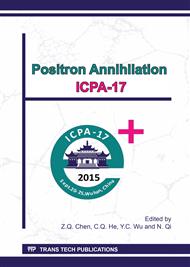[1]
T. P. Yu, A. Pukhov, Z. M. Sheng, F. Liu, and G. Shvets, Bright Betatronlike X Rays from Radiation Pressure Acceleration of a Mass-Limited Foil Target, Phys. Rev. Lett., 2013, 110(4), 045001.
DOI: 10.1103/physrevlett.110.045001
Google Scholar
[2]
A. R. Bell and J. G. Kirk, Possibility of prolific pair production with high-power lasers, Phys. Rev. Lett., 2008, 101(20), 200403.
DOI: 10.1103/physrevlett.101.200403
Google Scholar
[3]
C. Ridgers, C. S. Brady, R. Duclous, J. Kirk, K. Bennett, T. Arber, and A. Bell, Dense electronpositron plasmas and bursts of gamma-rays from laser-generated quantum electrodynamic plasmas, Phys. Plasmas, 2013, 20(5), 056701.
DOI: 10.1063/1.4801513
Google Scholar
[4]
R. Ruffini, G. Vereshchagin, and S.S. Xue, Electron-positron pairs in physics and astrophysics: from heavy nuclei to black holes, Phys. Rep., 2010, 487(1-4), 1-140.
DOI: 10.1016/j.physrep.2009.10.004
Google Scholar
[5]
B. A. Remington, High energy density laboratory astrophysics, Plasma Phys. Control. Fusion, 2005, 47(5), 191203.
Google Scholar
[6]
Y. C. Wu, J. Jiang, S. J. Wang, A. Kallis, and P. G. Coleman, Porosity and crystallization of water ice films studied by positron and positronium annihilation, Phys. Rev. B, 2011, 84(6), 064123.
DOI: 10.1103/physrevb.84.064123
Google Scholar
[7]
C. Müller and C. H. Keitel, Antimatter: Abundant positron production, Nat. Photon., 2009, 3(5), 245-246.
Google Scholar
[8]
J. Jiang, Y. C. Wu, X. B. Liu, R. S. Wang, Y. Nagai, K. Inoue, Y. Shimizu, and T. Toyama, Microstructural evolution of RPV steels under proton and ion irradiation studied by positron annihilation spectroscopy, J. Nucl. Mater., 2015, 458, 326-334.
DOI: 10.1016/j.jnucmat.2014.12.113
Google Scholar
[9]
Y. H. Yan, B. Zhang, Y. Wu, K. Dong, Z. Yao, and Y. Gu, Comparison of direct and indirect positron-generation by an ultra-intense femtosecond laser, Phys. Plasmas, 2013, 20(10), 103114.
DOI: 10.1063/1.4826219
Google Scholar
[10]
C. P. Ridgers, J. G. Kirk, R. Duclous, T. G. Blackburn, C. S. Brady, K. Bennett, T. D. Arber, and A. R. Bell, Modelling gamma-ray photon emission and pair production in high-intensity laser-matter interactions, J. Comput. Phys., 2014, 260(0), 273-285.
DOI: 10.1016/j.jcp.2013.12.007
Google Scholar
[11]
A. Pukhov and J. Meyer-Ter-Vehn, Laser wake field acceleration: the highly non-linear brokenwave regime, Applied Physics B Lasers and Optics, 2002, 74(4-5), 355-361.
DOI: 10.1007/s003400200795
Google Scholar
[12]
G. Sarri, W. Schumaker, A. Di Piazza, M. Vargas, B. Dromey, M. E. Dieckmann, V. Chvykov, A. Maksimchuk, V. Yanovsky, and Z. He, Table-top laser-based source of femtosecond, collimated, ultrarelativistic positron beams, Phys. Rev. Lett., 2013, 110(25), 255002.
DOI: 10.1103/physrevlett.110.255002
Google Scholar


